Intel Mobile Penryn Benchmarked: Battery Life Improves Again
by Anand Lal Shimpi on January 7, 2008 12:00 AM EST- Posted in
- CPUs
Mobile Penryn vs. Merom: Performance
What about raw performance? MobileMark 2007 does measure performance during the course of running the Productivity 2007 suite:
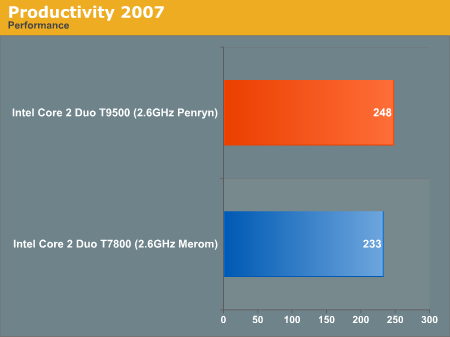
With a 6.4% increase in performance, the mobile Penryn saw a 16% increase in battery life. Remember that when you’re talking about running on battery power, being able to complete tasks faster can mean better overall battery life. The quicker a system can finish its work and move down to an idle state, the better.
Looking at our usual metrics, the Penryn based Core 2 Duo T9500 is still marginally faster than its Merom based predecessor across the board. SYSMark 2007 shows an overall increase of around 4.5%, with individual benchmarks showing an improvement in the 1 - 8% range.
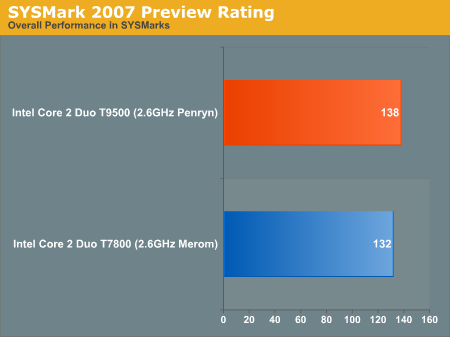
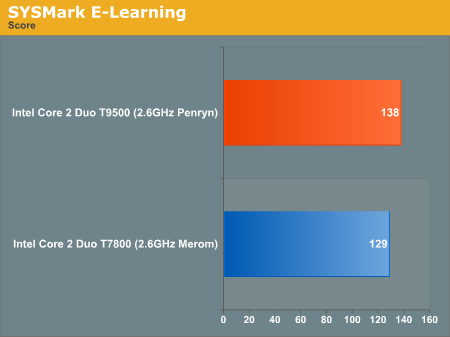
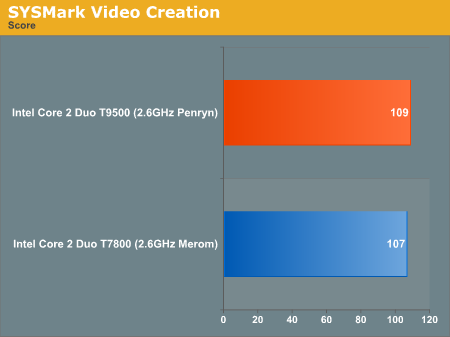
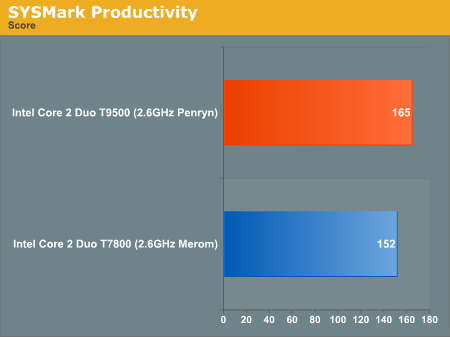
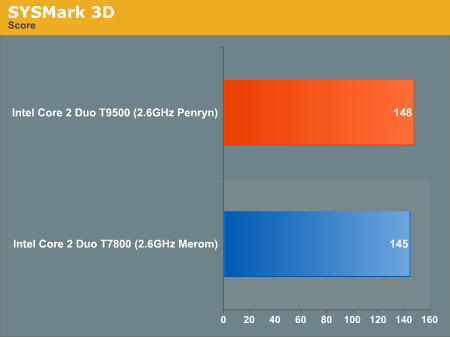
Media encoding performance is slightly better on the T9500, with our DivX and x264 tests completing 4.7% and 2.8% faster, respectively. Again, we don’t see an earth shattering improvement, but when you keep in mind that we can even talk about a performance improvement in the same breath as an improvement in battery life, we can’t really complain.
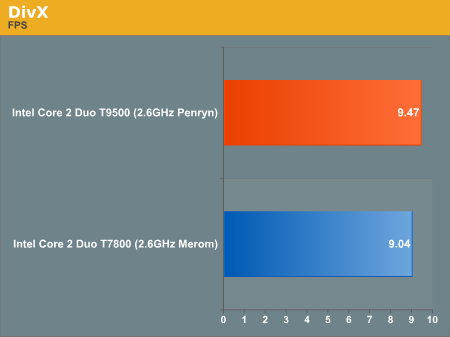
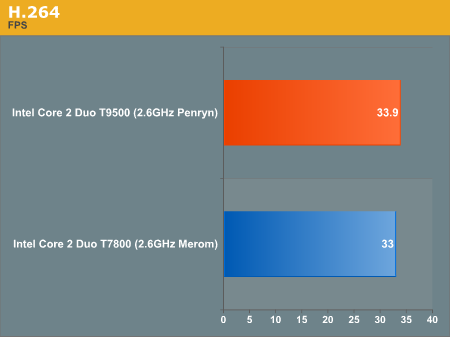
We ran a quick spotcheck on 3D rendering performance using Cinebench R10:
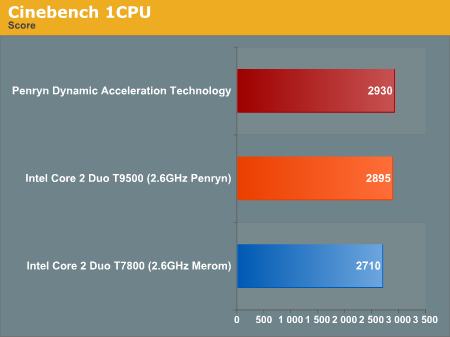
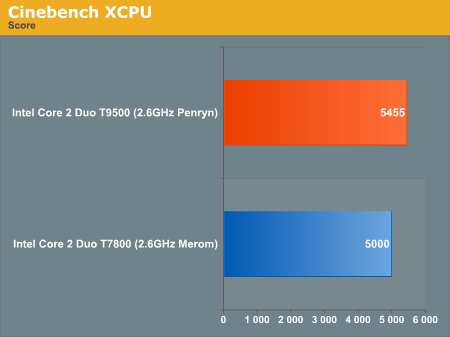
The single core tests show Penryn with a 6.8% performance advantage, while the multi-threaded benchmark grows that to 9.1%. Since Penryn has a 50% larger L2 cache, sharing data between the cores becomes a little easier and thus we see a small boost in the multi-threaded scaling factor.
Gaming benchmarks were out of the question given that our D630s shipped with Intel integrated graphics, but even armed with discrete graphics we’d expect Penryn to just slightly edge out Merom.
Testing Intel’s Dynamic Acceleration Technology
When Penryn was announced Intel promised a feature that sounded kind of interesting. The idea was that when running single threaded applications, a mobile Penryn would use the extra thermal headroom created by having a completely idle second core and increase the clock speed of the working core.
The performance boost would amount to nothing more than a single speedgrade (2.8GHz on our 2.6GHz chip), but the impact would be that you wouldn’t sacrifice any single threaded performance even on a multi-core CPU. One of the tradeoffs of building a dual-core CPU over a single-core is that you can’t generally hit clock frequencies that are as high, this technology gets around that.
We were skeptical about how the technology would work when we first heard about it. OSes like Windows Vista bounce threads from one core to the next, so a single core is never allowed to be completely idle for too long. Regardless, we wanted to try Intel’s “Dynamic Acceleration Technology” to see if: 1) we could get it to work and 2) if it made a difference.
Just as we suspected, getting it to work even while running a single threaded application was virtually impossible. We used CPU-Z to monitor clock speed while running single threaded applications, and our clock frequency never jumped above 2.6GHz. It wasn’t until we forced the processor affinity of an application to a single CPU core that we could actually see Intel’s DAT in action.
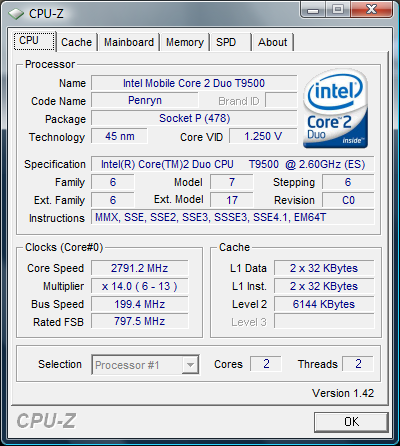
Even when enabled however, the impact was far less dramatic than you’d think. The working core will only increase its operating frequency as long as it has the thermal headroom to do so, which at times may only be for a matter of a second or two. When running the single-threaded Cinebench test our T9500 would increase its clock speed to 2.8GHz but only for very short periods of time. The result was a 2.6GHz CPU that every now and then ran at 2.8GHz, and the increase in performance reflected this.
With a 1.2% increase in performance due to Intel’s DAT, we can’t really get excited about this technology. It’s very rare that it will be working, and when it is the 7.7% increase in clock speed just isn’t enough to increase performance significantly at all. It looks like Intel’s DAT is more of a gimmick rather than something to get excited about.










18 Comments
View All Comments
metacircular - Friday, January 11, 2008 - link
Thanks for the review, but could the reviewers comment on the temperature differences between the two processors? I'm assuming lower voltage will result in less heat, but it would be nice to see some numbers.legoman666 - Thursday, January 10, 2008 - link
It's a shame about that DAT not really being useful. It seems like their ideas were hampered by the fact that applications always bounce from 1 core to another. Looks/sounds like a good idea though.Jussi - Wednesday, January 9, 2008 - link
Thanks for an interesting article, Penryn it seems like a nice, although not essential refresh.I'd like to nitpick the SSE4 performance numbers. You state that in case of Virtualdub "Penryn would offer a greater than 40% increase in performance". I find this to be incorrect.
Let performance or speed (v) be defined as v = work unit / time. v1 is the speed of Merom and v2 is the speed of Penryn. Comparing Penryn to Merom = v2/v1 => t1/t2. Using your numbers 47.3s / 28.2s = 1.677 => 68% better performance.
It would be correct to state that using Penryn takes about 40% less time to do the job, but that is not what the article states.
puffpio - Tuesday, January 8, 2008 - link
Could I just swap chips out?channelv - Wednesday, January 9, 2008 - link
Yup, the D630 uses the 965 chipset (Santa Rosa). But you'd better wait for a BIOS update from Dell first before you think about putting a Penryn in there - I'd expect those to roll out almost any day now, but by Feb. for sure.Mr Alpha - Tuesday, January 8, 2008 - link
Have I understood it correctly, that you are comparing the SSE4 version of DivX on Penryn with the same SSE4 version of DivX on Merom? Shouldn't you be comparing the SSE4 version of DivX on Penryn to the SSE3 version of DivX on Merom?mi1400 - Tuesday, January 8, 2008 - link
Electric surges drain battery faster. When a device bulb, motor etc starts a peak is occured in load and then load comes to a lesser and steady value. Intel Dynamic Acceleration may result in same for battery.Mgz - Monday, January 7, 2008 - link
how about the Deep Power Down (C6) stage that penryn brings ? Any test on this feature?coolme - Monday, January 7, 2008 - link
Good review, but just to note.Merom (part of santa rosa) supports Intel Dynamic Acceleration, (although T7xxx series only) and since you guys weren't aware of that, the cinebench benchmark (and other benchmarks) with the T7800 might have a skewed score.
duploxxx - Monday, January 7, 2008 - link
Nice to see that the t9xxx series will step up the performance again and battery life. Altough we can already say that Intel dominated this part of the mobile market for a long time with t7xxx it is now sure that it will increase that even more.what i really want to no is what about low end and midstream, how good are these t2xxx - t5xxx - t7xxx series compared to each other and what happens when you put a rather cheap turion class next to those t2 and t5 series.
@anand i think you would hit a readers max out of such a review, but then again it would take a lot of time and effort to get a nice compare with equal hardware parts and price....